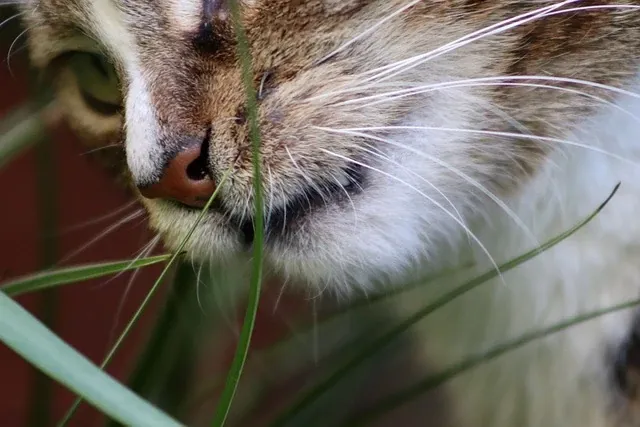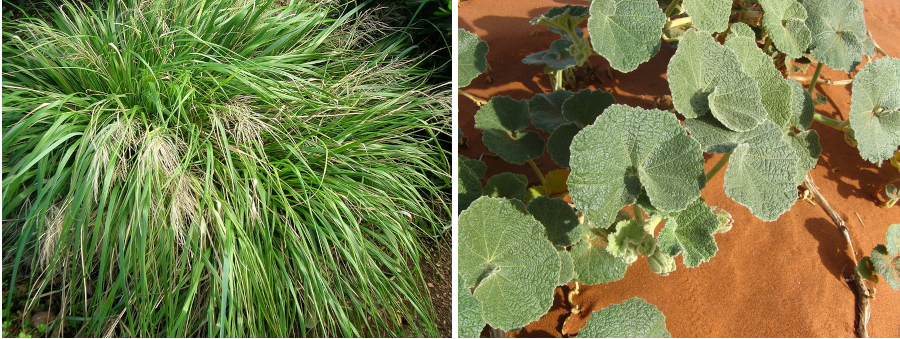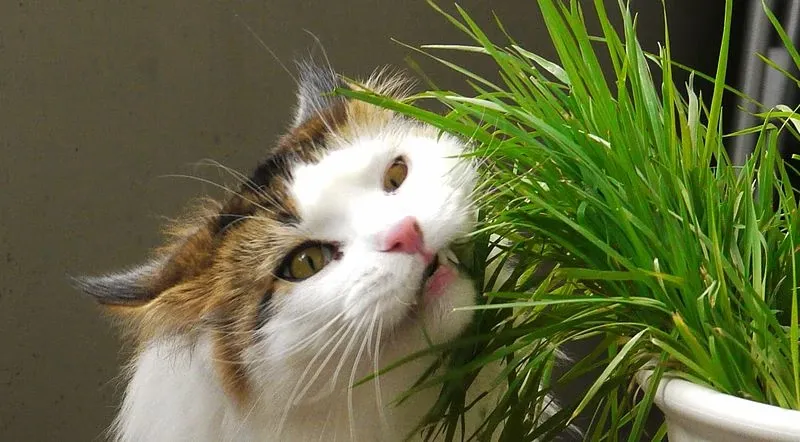Why do Cats Eat Grass? And Should They?
Cats across different species – big, small, domestic and wild – actively seek out grass or greenery. There are many theories about grass eating – some more compelling than others. The bottom line is that eating bits of greenery fulfills a purpose to felines and is normal behaviour in healthy cats.

Cat carers have probably all seen their cats eat a few plucks of grass or a nibble of greenery. All cats – even lion, tiger and leopard in the wild – frequently exhibit grass eating 1, 2, 3.
...pervasiveness of grass noshing
Pieces of plant material consistently show up in feline scat analyses across cat species 3, 4, 5. A web-based study with domestic cats revealed that 80% of them ate grass with some regularity 6.
A more recent study revealed that 65% of cats ingested bits of plant material often – at least weekly 7.
Interestingly, younger cats ate grass more frequently than older adults. Only 11% of cats were reported to never gobble greenery 7, 8.
These percentages showcase just how common this behaviour is.
...nature or nurture?
Grass eating happens so consistently, across feline species, that they seem hard wired to this behaviour. A variety of other carnivores are also frequently seen gnawing on plants 7.
Single cat households can attest to the fact that this behaviour emerges spontaneously, without their cat ever being exposed to this behaviour from other cats.
...puzzling behaviour
It remains strange that a clade of obligate carnivores that lack the enzymes to effectively break down plant matter 9, would frequently seek out greenery.
Plus, cats have specialised dentition that are incapable of grinding plant material in preparation for digestion 10. They mostly gnaw through or pluck off pieces of grass and simply swallow them.
Even more puzzling is that plant matter mostly passes through the digestive tract virtually undigested. Blades of grass in their scats are often visible to the naked eye.
In many cases these strands are somewhat discoloured, but still recognisable.
...field observations
The Southern African wildcat – the closest ancestor of the common house cat – also exhibits grass nibbling 5. And they seem quite meticulous about their plant choice.
They mostly favour Eragrostis sp. – a wild grass (image below on the left). Or bits of leaves from the tart, bitter Radyera urens plant (image below on the right). Their scat analyses revealed bits of plant matter in 42.3% of the tested samples 5.

Dr Esther Plantinga reported similar behaviour in feral cats. They also frequently consumed a few bites of mostly grass 11.
These findings collectively demonstrate that cats instinctively eat bits of greenery. And it must serve some purpose. In domestic cats, it is viewed as the remnants of a trait inherited from their wild ancestors 6.
However, there are many additional theories that have been suggested.
...the nutritional boost theory
A popular theory is that cats eat grass for phyto- or micronutrients. Some believe it provides folic acid, which helps to carry oxygen through the blood stream 12.
However, this theory is unconvincing and probably not the main reason for grass consumption. Experts concluded long ago that the vegetal material ingested is so minimal.
Moreover, the plants favoured are so low in nutrients that they probably do not serve any nutritional purpose 5, 13.
Again, when the grass is regurgitated or passed through the bowel, it is virtually undigested.
...digestive aid theory
It is not impossible that cats may use greenery to aid in digestion, much like we use herbs or botanical bitters to aid our digestion. One of the plants chosen by the Southern African wildcat, could fit this profile as it is is a very tart, acrid plant.
Could they instinctively choose this bitter plaint for improved digestions? Though it is a possibility, if the plant or herb is not digested to release the helpful compound, this theory falls flat.
...the dietary fibre theory
Some feel that grass adds roughage and a laxative effect. They believe that plant fibres are stool bulking and softening agents in cats 14, 15.
However, cats have very little to no requirement for dietary fibre 15, 16, 17, 18. All fibre is derived from plants 18 – this much is true.
But cats in the wild rely entirely on non digestible proteins for roughage, stool motility and the cultivation of healthy intestinal flora populations 16, 19.
But there is another obvious point. Most cats nowadays eat ultra processed, plant rich, man-made diets.
These foods are already so high in plant fibre, that a few plucks of grass are unlikely to make any difference to stool motility.
...the illness trigger
There are many who believe that illness triggers grass eating. However, an average of 92.5% of cat carers in a research study reported that their cats did not appear sick in any way before they nibbled on grass 7.
Only 5% or 6% of cats that ate greenery showed signs of illness. This proportion is so low that it does not really support the idea that illness triggers plant eating.
...an emetic aid
Some feel that greenery induces vomiting. This is true, but to a limited extent. Only about a third of grass eating sessions end in vomiting 8.
Researchers concluded that vomiting is an occasional by-product of and not the main reason for grass gobbling. However, throwing up from grass is noticeable enough to suggest some link to gastric discomfort 7.
It may help to rid cats of hairballs and undigested matter in the gastrointestinal tract. It may also sometimes assist in expelling unused stomach juices, lovingly referred to as hunger or acid pukes 20.
Overly hungry cats may sometimes use grass to quicken digestive juice expulsion to prevent irritation of the stomach's lining.
Quite possibly, small wildcat might also expel stomach juices after a failed hunt to protect their stomachs.
Grass eating, followed by a frothy, clear puke or a yellow liquid puke is characteristic of stomach juice expulsion 20.
However, most cats nowadays forage on dry food all day and do not experience intense hunger.
...parasite prevention
Norwegian researchers put forward an interesting theory. They believe that cats – like other species of wild animals – use grass to help increase intestinal muscle activity 8, known as peristalsis.
This may help eliminate possible parasites from the gastrointestinal tract. It also explains why not all grass eating leads to vomiting, but that grass may serve a purpose deep in the feline gut.
An extensive research review revealed co-occurrence of intestinal parasites with grass in feline scats in a number of cases.
This prompted the theory that fibrous plant material may help to regularly sweep parasites from the gut 7.
...clever cat
Before we jump on the dewormers, plant eating is not an indication that a cat has parasites. But it may be an innate behaviour to prevent potential intestinal parasites from getting a foothold.
Younger, growing cats are more open to serious nutritional costs from intestinal parasites, which explains why they more often ingest greenery compared to older cats 7.

...a remaining air of mystery
There's no single catch-all theory to explain all grass eating in cats. Even though the above theories might each be true to some extent, there is still much speculation about this behaviour.
The simple act of eating grass is a complex behaviour that is poorly understood and that has multidimensional causes.
...The bottom line
Be as it may, grass eating is viewed as normal behaviour. A pluck of grass is probably healthy, but a cat mowing down a patch of lawn might be reason for concern.
A sudden increase in grass-eating behaviour could be a sign of intestinal distress, and cats might need to see a vet without delay.
...beware poisonous plants
Cats have a pressing propensity to nosh. But messing with the wrong plant can be fatal.
Cat carers are also advised to keep cats away from chemically treated lawns. It is best to cultivate a little cat garden so they can get their munch on safely.
The ASPCA provides a very helpful list of poisonous and also safe plants for cats (https://www.aspca.org/pet-care/animal-poison-control/cats-plant-list accessed on April 5, 2023).
Hopefully this resource will further help to keep cats safe. Lesson #3 of our Nature Mimicking Chef School discusses how to cultivate your own cat garden in detail.


References
1 Wildlife Trip (2021). What do leopards eat? Discover the leopard diet. Retrieved March 27, 2023, from https://wildlifetrip.org/what-do-leopards-eat/
2 Wild Explained (n.d.). Do lions eat grass? [Yes! Here’s why]. Retrieved March 27, 2023, from https://wildexplained.com/do-lions-eat-grass/
3 Ackerman, B.B., Lindzey, F.G. & Hemker, T.P. (1984). Cougar food habits in Southern Utah. Journal of Wildlife Management, 48(1), 147 – 155.
4 Robinette W.L., Gashwiler J.S. & Morris O.W. (1959). Food habits of the cougar in Utah and Nevada. Journal of Wildlife management, 23, 261 – 273.
5 Herbst, M. & Mills, M.G.L. (2010). The feeding habits of the Southern African wildcat, a facultative trophic specialist, in the southern Kalahari (Kgalagadi Transfrontier Park, South Africa/Botswana). Journal of Zoology, 280, 403 – 413.
6 Hart, B.L. (2008). Why do dogs and cats eat grass? Veterinary Medicine, December, 648 – 649.
7 Hart, B.L., Hart, L.A., Thigpen, A.P. & Willits, N.H. (2021). Characteristics of plant eating in domestic cats. Animals, 11, 1853; https://doi.org/10.3390/ani11071853
8 Shultz, D. (2019). Mystery solved?. Why cats eat grass. In Science. Retrieved April 4, 2023, from https://www.science.org/content/article/mystery-solved-why-cats-eat-grass
9 Hewson-Hughes, A.K., Hewson-Hughes, V.L., Miller, A.T., Hall, S.R., Simpson, S.J. & Raubenheimer, D. (2011). Geometric analysis of macronutrient selection in the adult domestic cat, Felis catus. Journal of Experimental Biology, 214, 1039 – 1051.
10 Bradshaw, J.W.S., Goodwin, D., Legrand-Defrétin, V. & Nott, H.M.R. (1996). Food selection by the domestic cat, an obligate carnivore. Comparative Biochemistry and Physiology Part A: Physiology 114(3), 205 – 209.
11 Plantinga, E.A., Bosch, G. & Hendriks, W.H. (2011). Estimation of the dietary nutrient profile of free-roaming feral cats: Possible implications for nutrition of domestic cats. British Journal of Nutrition 106(S1), S35 – S48.
12 Greencross Vets (n.d.). Why do cats eat grass? Retrieved April 4, 2023, from https://www.greencrossvets.com.au/pet-library/articles-of-interest/why-do-cats-eat-grass/
13 Moleón, M. & Gil-Sánchez, J.M. (2003). Food habits of the wildcat (Felis silvestris) in a peculiar habitat: the Mediterranean high mountains. Journal of Zoology, 260, 17– 22.
14 Frazier, A & Eckroate, M. (2008). The natural cat: The comprehensive guide to optimum cat. New York: Penguin Group, New York, NY.
15 TC Feline (n.d.). Constipation. Retrieved April 6, 2023, from http://tcfeline.com/constipation/
16 Katz, E. (2014). Answers: Do Cats Need Dietary Fiber? In Feline Nutrition Foundation. Retrieved April 6, 2023, from http://feline-nutrition.org/answers/answers-do-cats-need-dietary-fiber
17 Gross, K.L., Becvarova, I., Armstrong, P.J. & Debraekeleer, J. (2010) Feeding young adult cats: Before middle age. In S.H. Hand, C.D. Thatcher, R.L. Remillard, P. Roudebush & B.J. Novotny (Eds) (2010). Small Animal Clinical Nutrition, 5th ed. (p. 158). Topeka, Kansas: Mark Morris Institute.
18 Pierson, L.A. (2011). Making cat food. In Cat Info. Retrieved April 6, 2023, from http://catinfo.org/?ink=makingcatfood# The_Ingredients
19 Depauw, S., Hesta, M., Whitehouse-Tedd, K., Vanhaecke, L., Verbrugghe, A. & Janssens, G.P.J. (2013). Animal fibre: The forgotten nutrient in strict carnivores? First insights in the cheetah. Journal of Animal Physiology and Animal Nutrition, 97(1), 146 – 154.
20 Food fur Life (n.d.). How to manage acid and bile vomiting. Retrieved April 6, 2023, from https://www.foodfurlife.com/my-cat-is-vomiting---what-do-i-do.html#/
Disclaimer
The information provided on the Bestfedcats.com website is educational and informational. We are here to give guidance on how to feed a properly balanced raw diet. We also offer advice on how to improve the diet of the modern house cat. Please note that we are not veterinarians. We are not here to give veterinary advice. Best Fed Cats will not be held responsible for any adverse reactions to your cat based on the information on our website. The health of your cat depends entirely on you. We expect you to use your knowledge of your cats, their circumstances and their health – in conjunction with a trusted veterinarian – to determine if any advice provided on this site is appropriate for your cats.

